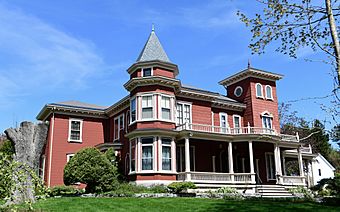Whitney Park Historic District facts for kids
Quick facts for kids |
|
|
Whitney Park Historic District
|
|
 |
|
| Lua error in Module:Location_map at line 420: attempt to index field 'wikibase' (a nil value). | |
| Location | Roughly bounded by 8th, Union, Pond and Hayford Sts., Bangor, Maine |
|---|---|
| Area | 18 acres (7.3 ha) |
| Architect | Multiple |
| Architectural style | Colonial Revival, Italianate, Queen Anne |
| NRHP reference No. | 88001844 |
| Added to NRHP | October 13, 1988 |
The Whitney Park Historic District is a special neighborhood in Bangor, Maine. It's a collection of 42 old houses built between 1850 and 1910. This was a very important time when Bangor was growing fast. The district is named after Whitney Park, a small park at Hammond and Cedar Streets. This area is protected because it shows what Bangor was like long ago. It was added to the National Register of Historic Places in 1988.
Exploring the Whitney Park District
The Whitney Park Historic District is on the west side of Bangor. It's north of Hammond Street and south of Cedar Street. North of Whitney Park, you'll find many old houses. These homes are well-kept and look similar in size. This area started to be built in the 1850s.
A Time of Growth for Bangor
Bangor was a very busy city in the 1850s. It was a major center for processing and shipping lumber. Because of this growth, many new homes were needed. The houses in the Whitney Park District show different styles of building that were popular from 1850 to 1910. The district is surrounded by shops and newer homes today.
Different Styles of Homes
The houses in the district show many different architectural styles. The oldest house is the Charles Jennings House at 15 Hayward Street. It was built around 1851-1853. It started as a simple Greek Revival style home. Later, it got some updates in the Colonial Revival style.
Many homes are in the Italianate style. These often have fancy details and tall windows. The William Arnold House at 47 West Broadway is a great example. It's a large, two-story house with two towers. Along West Broadway, you can also see Second Empire style houses. These homes have special sloped roofs called mansard roofs. The lots for these houses on West Broadway were among the first to be laid out. They are quite large, about one acre each.
Later styles are also found in the district. These include the Queen Anne style, known for its towers and varied textures. The Shingle style, which uses wood shingles on the walls, is also present. And the Colonial Revival style, which looks back to older American building traditions, is well-represented.

